Civic Center Park & Smith Park
Introduction
Text-to-speech Audio
Located adjacent to historic City Hall, Civic Center Park is the site for many municipal events and celebrations. It is where St. Joseph gathers to remember its history, to celebrate the Chiefs, and to eat amazing barbeque. It is a lovely open space with trees, paths, and the wonderful dolphin fountain. It is also the site of several memorials to veterans and fallen first responders.
Images
1897 Sanborn Map showing the location of Smith Park
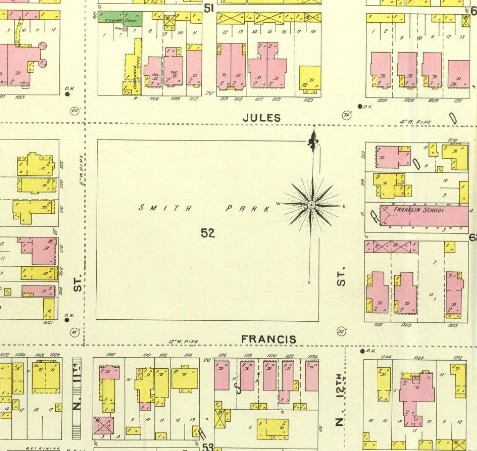
Encouraging St. Joseph voters to support the creation of Civic Center Park in 1919
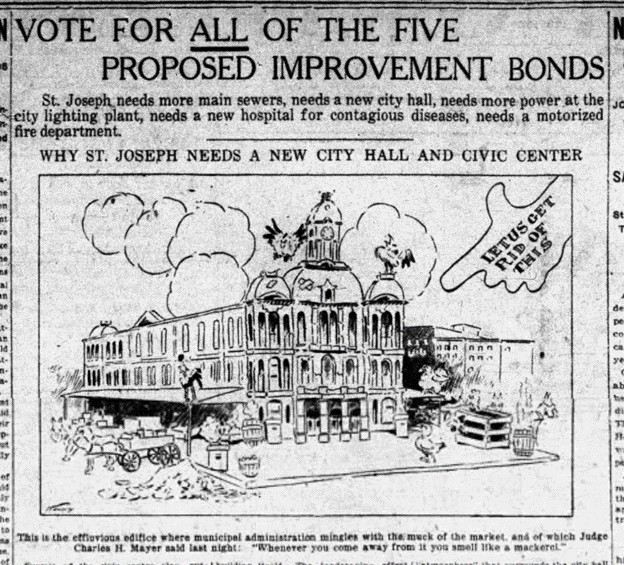
One of the ambitious proposals for the Civic Center in 1923
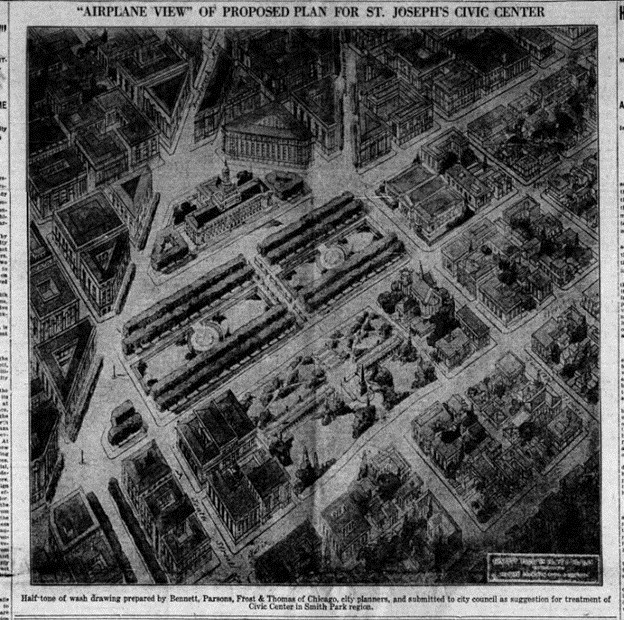
The park has long been the site of sports related civic gatherings. This is a party for the World Series in 1934
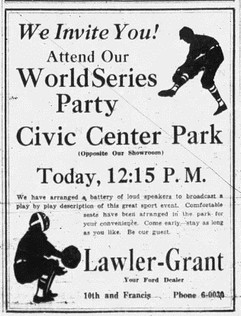
St. Joseph is the home of the Chiefs' training camp, celebrated each year with a Red Rally
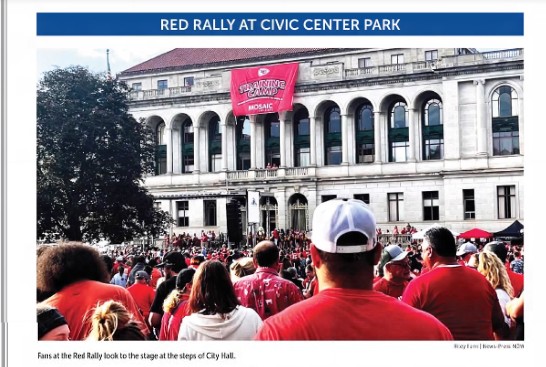
The dolphin fountain is one of the primary features of Civic Center Park
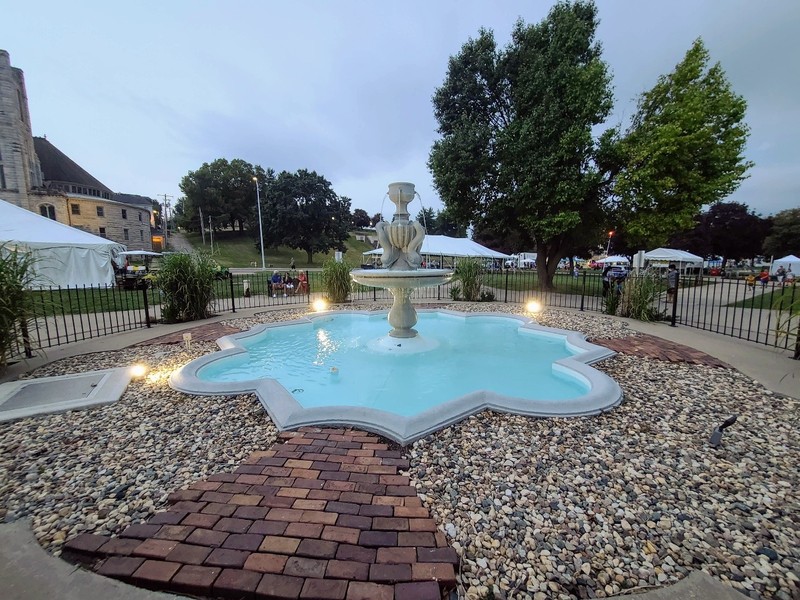
View from the hill in Smith Park showing Civic Center Park and City Hall
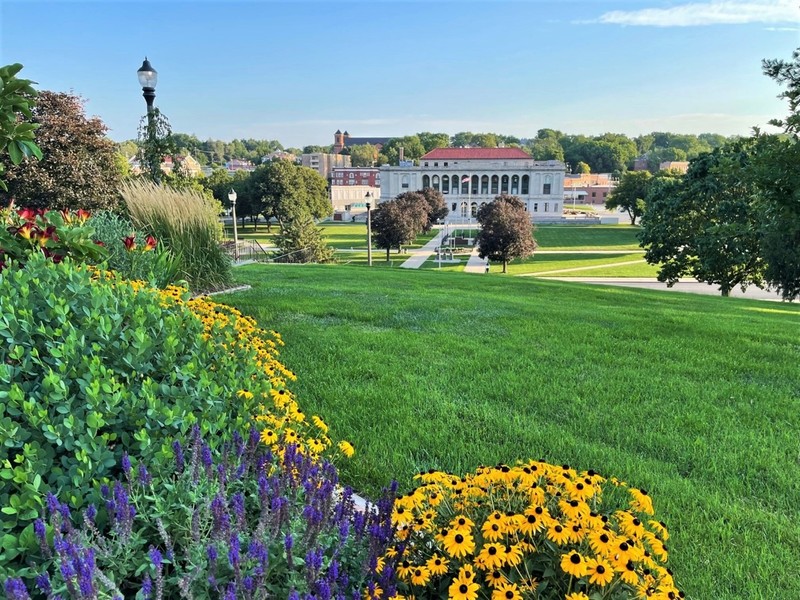
The hill in Smith Park and the Museum Hill Historic District in the background
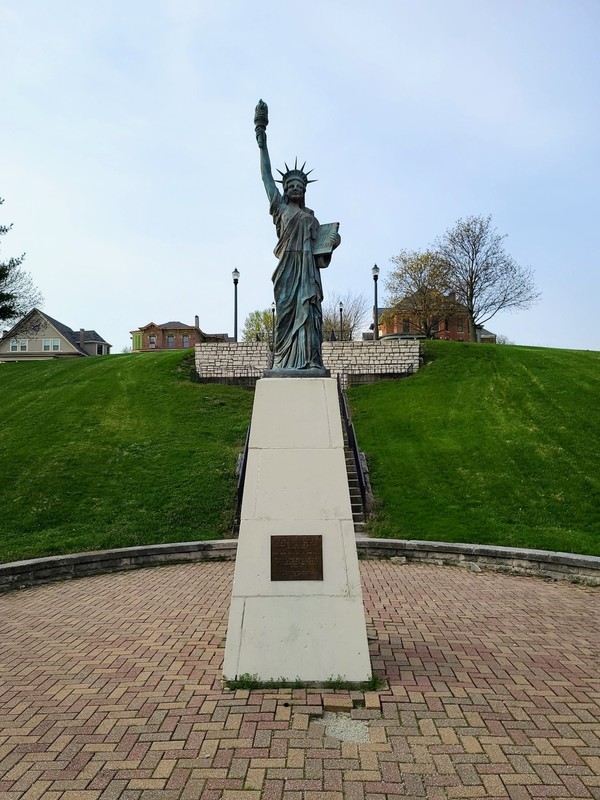
Backstory and Context
Text-to-speech Audio
In March 1855, Frederick Smith donated nearly 2 acres to the newly formed city of St. Joseph for use as a public park. It was St. Joe’s first public park. It boasted ornate iron fencing, lighting, drinking fountains, and public art.
After World War I, St. Joseph, like much of the nation, was looking forward. The drive was to embrace the new and the modern and to leave the past behind. In 1919, the city government decided that the time had come to leave behind the old city hall and municipal facilities located at Market Square and to create a modern Civic Center. The plan was to build a new City Hall and other municipal structures around a park, much like the National Mall in Washington, D.C. Voters approved the plan and the search for an appropriate site commenced.
Eventually, city leaders decided to enlarge the existing Smith Park to create the Civic Center. In order to do so, a large number of existing structures had to be acquired and demolished; a plan that proved controversial. Ninety-two parcels were condemned for the project. Among the structures demolished were the Knights of Columbus building and the Francis Street Baptist Church in addition to many residences and commercial structures.
The Park Commission requested proposals for the project from landscape architects across the nation. The plans submitted envisioned a grand district with lovely plantings surrounded by museums, municipal buildings, and the library. It was to embody the ambitions and optimism of the city. The park was created and the new City Hall built (it opened in 1926), but the rest of the grand plan was never created, falling victim to the economic downturn.
Though the plan for the grand Civic Center did not come to fruition, Civic Center Park was immediately popular and has been the site of large community gatherings. Candidates for political office gave speeches at the park. In July 1938 Governor Lloyd C. Spark spoke to an audience of more than 3,000. Thomas E. Dewey spoke in 1940. And when the time came to celebrate victory in World War II – Civic Center Park was the obvious choice of venue for the mass meeting.
Civic Center Park is the location of choice for city festivals. In 1963, the Midland Empie Fall Arts Festival brought hundreds to the park. Every Spring, events associated with the Apple Blossom Festival occur there. Trails West! an arts festival designed to commemorate St. Joseph’s role in westward expansion was an annual event in August from 1993-2018. It brought thousands of people to the park to enjoy the art, food, and entertainment.
The park has provided St. Joseph citizens with the opportunity to show enthusiasm for national sporting events. In 1934, a World Series Party was held, and more recently, annual “Red Rallies” have been held to illustrate the city’s support for the Kansas City Chiefs.
The shade provided by the trees and the relief from the fountain make Civic Center Park a favorite place to cool off in the summer, prompting the 1944 Gazette to describe it as the city’s “back yard.”
Civic Center Park provides a wonderful place to relax and enjoy views of the historic architecture of the Museum Hill Historic District and City Hall and is an easy walk to the attractions of charming downtown St. Joseph.
Sources
“Vote for All of the Five Proposed Improvement Bonds,” St. Joseph News Press, May 15, 1919.
“Civic Center Plan is Made Plain at Dinner,” St. Joseph News Press, May 17, 1919.
“Explain Value of City Civic Center,” St. Joseph Gazette, May 20, 1919.
“Will Get the Civic Center Plans Ready,” St. Joseph News Press, June 19, 1919.
“Smith Park District for the Civic Center,” St. Joseph News Press, Nov. 9, 1922.
“Civic Center From an ‘Airplane View’,” St. Joseph News Press, June 30, 1923.
“Park Executives Laud Plans Here,” St. Joseph Gazette, Sept. 16, 1923.
“Park Board Resorts to Injunction to Prevent Election on Civic Center Park Ordinances,” The Fraternalist, Sept. 25, 1924.
“Starmer, Shull, Curd and Eastin Take up Issues,” St. Joseph Gazette, March 28, 1926.
“K. of C. Building is Biggest to be Taken,” St. Joseph News Press, April 9, 1926.
St. Joseph Gazette, Oct. 3, 1934.
Riley Funk, “Sea of Red,” St. Joseph News Press, July 30, 2022.
“Speech Heard Afar,” St. Joseph News Press, July 15, 1938.
“Plans Being Made for Dewey Talk in Civic Center Park,” St. Joseph News Press, Oct. 31, 1940.
“Hot Weather Causes Rush to City Parks and Pools,” St. Joseph Gazette, Aug. 4, 1944.
“V-Day Program is Worked Out,” St. Joseph Gazette, Aug. 16, 1944.
“To Perform at Arts Festival,” St. Joseph News Press, Oct. 2, 1963.
St. Joseph News Press, May 15, 1919
St. Joseph News Press, June 30, 1923
St. Joseph Gazette, Oct. 3, 1934
